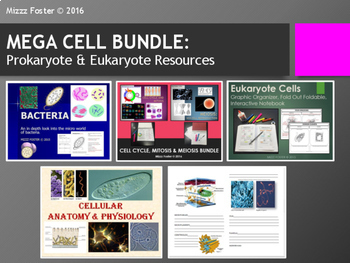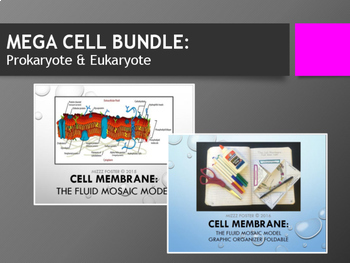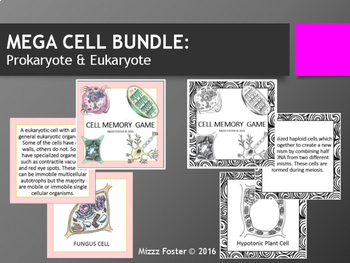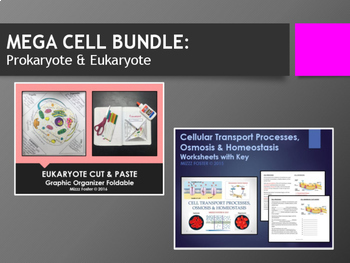MEGA Cell Bundle: Prokaryote and Eukaryote, Simple and Complex Cells
Mizzz Foster
1.5k Followers
Products in this Bundle (20)
showing 1-5 of 20 products
Description
This is MEGA bundle featuring ALL my cell products for prokaryotes and eukaryotes.
I will be adding more products in the future and adjust the price accordingly if purchase now you will receive FREE additions.
This MEGA Bundle contains power points with accompanying guided notes. There are notes for regular and GT students as well as modified notes with fill in the blank for students with IEP and 504 or students who struggle with handwriting.
The two sets of word wall coloring sheets are great for introducing the lesson following a test or if you need extra credit options or sub lessons.
THIS BUNDLE IS GREAT FOR ANY STATE!!!
Please remember to leave feedback for TpT credit and follow me for a free monthly giveaway.
Texas Biology TEKs:
(4) Science concepts. The student knows that cells are the basic structures of all living things with specialized parts that perform specific functions and that viruses are different from cells. The student is expected to:
(A) compare and contrast prokaryotic and eukaryotic cells;
(B) investigate and explain cellular processes, including homeostasis, energy conversions, transport of molecules, and synthesis of new molecules; and
(C) compare the structures of viruses to cells, describe viral reproduction, and describe the role of viruses in causing diseases such as human immunodeficiency virus (HIV) and influenza.
(5) Science concepts. The student knows how an organism grows and the importance of cell differentiation. The student is expected to:
(A) describe the stages of the cell cycle, including deoxyribonucleic acid (DNA) replication and mitosis, and the importance of the cell cycle to the growth of organisms;
(B) examine specialized cells, including roots, stems, and leaves of plants; and animal cells such as blood, muscle, and epithelium;
(C) describe the roles of DNA, ribonucleic acid (RNA), and environmental factors in cell differentiation; and
(D) recognize that disruptions of the cell cycle lead to diseases such as cancer.
Next Generation Science Standards:
HS-LS1-1. Construct an explanation based on evidence for how the structure of DNA determines the structure of proteins which carry out the essential functions of life through systems of specialized cells.
HS-LS1-4. Use a model to illustrate the role of cellular division (mitosis) and differentiation in producing and maintaining complex organisms.
HS-LS1-2. Develop and use a model to illustrate the hierarchical organization of interacting systems that provide specific functions within multicellular organisms.
LS1.A: Structure and Function
Systems of specialized cells within organisms help them perform the essential functions of life. (HS-LS1-1)
All cells contain genetic information in the form of DNA molecules. Genes are regions in the DNA that contain the instructions that code for the formation of proteins, which carry out most of the work of cells. (HS-LS1-1) (Note: This Disciplinary Core Idea is also addressed by HS-LS3-1.)
Multicellular organisms have a hierarchical structural organization, in which any one system is made up of numerous parts and is itself a component of the next level. (HS-LS1-2)
Feedback mechanisms maintain a living system’s internal conditions within certain limits and mediate behaviors, allowing it to remain alive and functional even as external conditions change within some range. Feedback mechanisms can encourage (through positive feedback) or discourage (negative feedback) what is going on inside the living system. (HS-LS1-3)
LS1.B: Growth and Development of Organisms
In multicellular organisms individual cells grow and then divide via a process called mitosis, thereby allowing the organism to grow. The organism begins as a single cell (fertilized egg) that divides successively to produce many cells, with each parent cell passing identical genetic material (two variants of each chromosome pair) to both daughter cells. Cellular division and differentiation produce and maintain a complex organism, composed of systems of tissues and organs that work together to meet the needs of the whole organism. (HS-LS1-4)
I will be adding more products in the future and adjust the price accordingly if purchase now you will receive FREE additions.
This MEGA Bundle contains power points with accompanying guided notes. There are notes for regular and GT students as well as modified notes with fill in the blank for students with IEP and 504 or students who struggle with handwriting.
The two sets of word wall coloring sheets are great for introducing the lesson following a test or if you need extra credit options or sub lessons.
THIS BUNDLE IS GREAT FOR ANY STATE!!!
Please remember to leave feedback for TpT credit and follow me for a free monthly giveaway.
Texas Biology TEKs:
(4) Science concepts. The student knows that cells are the basic structures of all living things with specialized parts that perform specific functions and that viruses are different from cells. The student is expected to:
(A) compare and contrast prokaryotic and eukaryotic cells;
(B) investigate and explain cellular processes, including homeostasis, energy conversions, transport of molecules, and synthesis of new molecules; and
(C) compare the structures of viruses to cells, describe viral reproduction, and describe the role of viruses in causing diseases such as human immunodeficiency virus (HIV) and influenza.
(5) Science concepts. The student knows how an organism grows and the importance of cell differentiation. The student is expected to:
(A) describe the stages of the cell cycle, including deoxyribonucleic acid (DNA) replication and mitosis, and the importance of the cell cycle to the growth of organisms;
(B) examine specialized cells, including roots, stems, and leaves of plants; and animal cells such as blood, muscle, and epithelium;
(C) describe the roles of DNA, ribonucleic acid (RNA), and environmental factors in cell differentiation; and
(D) recognize that disruptions of the cell cycle lead to diseases such as cancer.
Next Generation Science Standards:
HS-LS1-1. Construct an explanation based on evidence for how the structure of DNA determines the structure of proteins which carry out the essential functions of life through systems of specialized cells.
HS-LS1-4. Use a model to illustrate the role of cellular division (mitosis) and differentiation in producing and maintaining complex organisms.
HS-LS1-2. Develop and use a model to illustrate the hierarchical organization of interacting systems that provide specific functions within multicellular organisms.
LS1.A: Structure and Function
Systems of specialized cells within organisms help them perform the essential functions of life. (HS-LS1-1)
All cells contain genetic information in the form of DNA molecules. Genes are regions in the DNA that contain the instructions that code for the formation of proteins, which carry out most of the work of cells. (HS-LS1-1) (Note: This Disciplinary Core Idea is also addressed by HS-LS3-1.)
Multicellular organisms have a hierarchical structural organization, in which any one system is made up of numerous parts and is itself a component of the next level. (HS-LS1-2)
Feedback mechanisms maintain a living system’s internal conditions within certain limits and mediate behaviors, allowing it to remain alive and functional even as external conditions change within some range. Feedback mechanisms can encourage (through positive feedback) or discourage (negative feedback) what is going on inside the living system. (HS-LS1-3)
LS1.B: Growth and Development of Organisms
In multicellular organisms individual cells grow and then divide via a process called mitosis, thereby allowing the organism to grow. The organism begins as a single cell (fertilized egg) that divides successively to produce many cells, with each parent cell passing identical genetic material (two variants of each chromosome pair) to both daughter cells. Cellular division and differentiation produce and maintain a complex organism, composed of systems of tissues and organs that work together to meet the needs of the whole organism. (HS-LS1-4)
Total Pages
400+
Answer Key
Included
Teaching Duration
3 Weeks
Report this resource to TPT
Reported resources will be reviewed by our team. Report this resource to let us know if this resource violates TPT’s content guidelines.





